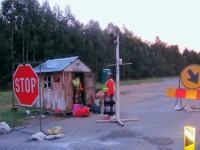
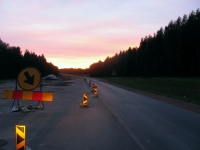
The news of a mega special (the Golden Pipit) that had arrived in Pongolo Nature Reserve in Zululand was all over the birding fraternity but I was not able to get away in the first week of it's appearance and it seemed unlikely that it would hang around for a second week. Then the news broke of another rarity not far from the Pipit - a Buff-breasted Sandpiper and within a day I had made plans to take the long trek to twitch both specials. My 5 year old son, Little Birdman, was up for the trip and Justin who I have birded with before, set out at 12:30am on Tuesday the 14th of December. The road was long, in a shocking condition with many sections that were single lane roads with stop/go systems which means you would park for up to 10 minutes before continuing behind massive trucks, and navigating the countless potholes required a lot of concentration and quick reactions.
The brilliant sunrise that greeted us as we approached Pongolo made up a little for the slow journey and the possibility that the clouded skies were clearing filled us with hope for a good day of birding. We would get 12 hours of birding in before we headed back at 6pm that same night! A 24-hour birding experience!
We arrived at the Pongolo Nature Reserve around 7am and headed straight for the spot where the Golden Pipit has been sighted. There was a car with an elderly couple who reported that they had seen the bird and it was in the area. Within 5 minutes we got our first sighting of the golden wonder as it settled on a marula tree close to my car. Every stop/go of the relentless road works on the long journey down suddenly paled into insignificance. He never sat still even when perched on top of the marula trees; exploding into a vertical take-off before plummeting earthwards and then settling on another tree with wings in a unique V-shape; chasing any bird that moved in the area; calling non-stop presumably in the hope of finding a mate; and occasionally disappearing to snack on a bug in the long grass beneath the marula trees. What keeps it here is a mystery - but we are so glad that it stayed long enough for us to be graced by it's presence. We come away with a sense of wonder and majesty from the encounter. I just wished that my photos could do justice to the beauty we saw.
Here are some scenery pics taken from the spot that the Golden Pipit has chosen as his home base for a while:
I was able to see Olive Tree-Warbler (a lifer for me) in the area and also saw Red-backed Shrike, Swainson's Spurfowl, Woolly-necked Stork and White-backed Vulture. The Spurfowl looked a bit disappointed that he was not receiving any attention!
We spent about an hour and a half at the spot and then made our way to Muzi Pans (on a route that led us through Mkuze Nature Reserve that we planned to bird on our return route). We arrived at the pans and were not too sure where to look for the Buff-breasted Sandpiper. Here is a panoramic shot of the waterway that connects the two pans on either side of the road.
Fortunately Phil Hockey was in the area and he confirmed that it had been seen that morning and that we would have to scan through the dozens of waders (mostly Ruff) to find it. The waders were some distance away from the road so it looked either doubtful that we would have much luck. We made our way to two trees on the edge of the plain and started to scan through all the waders. Here are some pics that show how many waders we had to scan through (and a pic of the scope that Justin was using - without it we would have really struggled to see much):
It took about ten minutes before Phil Hockey found the Buff-breasted Sandpiper and the scope was focussed on the bird and everyone got to take a look at this uniquely coloured Sandpiper. Unfortunately it stayed well out of my range but I will never forget what it looked like through the scope. These pics don't do justice but do confirm the sighting:
While we were all checking off the diversity of birds that were around the pan I heard Justin say, "There's a Pectoral too". I have made three trips to Mkhombo Dam and the two Pectoral Sandpipers had managed to hide from me each time. But now I was able to finally see them. Again, too far off for my pics to do justice, but still a valuable sighting!
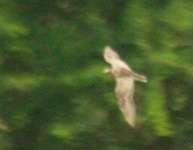
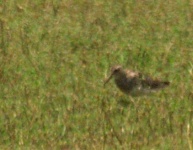
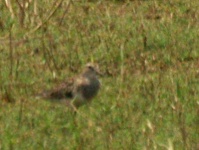
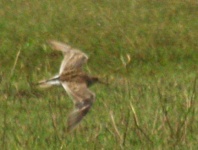 Apart from the Sandpipers which caused all the excitement there was a reat diversity of birds at the spot - here are some pics showing how many different birds there were at the water's edge:
Apart from the Sandpipers which caused all the excitement there was a reat diversity of birds at the spot - here are some pics showing how many different birds there were at the water's edge:
Here is a list of the birds that we saw on this pan (Blue-cheeked Bee-eater, African Spoonbill, Yellow-billed Stork, White-breasted and Reed Cormorant, Sacred and Hadeda and Glossy Ibis, Yellow-billed Duck, Hottentot and Red-billed Teal, Cattle and Great and Little Egret, Black-winged Stilt, Grey Heron, Yellow-billed Kite, African Pipit, Ruff, Common Greenshank, Wood Sandpiper, Klittlitz's Plover and Common Ringed Plover, Little Swift, Lesser Striped Swallow, Pin-tailed Whydah, African Darter, Blacksmith Lapwing, Southern Masked Weaver, Southern Red Bishop and Yellow Wagtail):
While we were out on the plain in front of the pan a chap approached us on a kayak and said that his name was Themba and that he was the guide at the adventure site owned by the community next to the pans (his cell number is 0731618189). A bit later I wanted to explore that side of the pan and drove up to the adventure resort and asked him for permission to bird from his property. He was quite happy as long as I gave him a donation (he seemed delighted with the R100 that I somewhat generously gave him). I considered hiring one of his kayaks but thought twice about it because I had just had a close encounter with a really large crocodile (at least 2 meters in length - that exploded from the water onto a bank not more than 20 meters from me while I was birding around the edge of the second pan!). And when I was processing my pics I noticed that not more than 30 meters from where Justin was scoping there was another large crocodile near the shoreline.
I spoke to Themba about the Pel's Fishing-Owl but he said that it had not been seen for the past 2 weeks and also that the Lesser Jacana were not present at the moment. I followed the road around the pan on Themba's property and got to see Yellow-throated Longclaw, Violet-backed Starling, Egyptian Goose, Yellow-billed Duck, some Yellow-billed Stork flew overhead and two Whiskered Tern hunted up and down the shoreline.
While birding on the other pan I saw Squacco Heron, African Jacana, Wood Sandpiper, a raptor flying overhead that may be African Harrier-Hawk:
Here are some birds that I have not been able to identify - they were among the waders (any ideas?):
Bird #1: (so far it seems like this is a juvenile Klittlitz's Plover)
Bird #2: (this will probably stay as a UFO)
Bird #3: (most likely Ruff)
Bird #4: (most likely Black-winged Stilt)
Bird #5: (most likely Black-winged Stilt)
We reluctantly left the pans as we needed to start morning towards home, and still wanted to get some decent time for birding at Mkuze Nature Reserve. We had an awesome time in the reserve with sightings of Broad-billed Roller which I have only seen once before and Trumpeter Hornbill:
The next bird we saw was a lifer for me - the Yellow-breasted Apalis:
By far my personal highlight was seeing Narina Trogon - in fact, it came close to upstaging the Golden Pipit! It took every ounce of our patience and determination to get close enough to photograph and to overcome the low-light conditions in the sand forest under the ominous dark clouds that had gathered). I have hunted for the Trogon in every forest that I have visited this year with no luck - and finally as a bonus it appears - talk about the cherry on the cake!
Here are some other birds we saw on our way through Mkuze Nature Reserve (we saw Yellow-bellied Greenbul but I was not quick enough to get a pic):
One of the birds that I am struggling to confirm is this Pelican - I think it may be Pink-backed rather than Great White. Any thoughts? (This bird has been confirmed as Pink-backed - an unexpected lifer for me!)
The last bird I am struggling with this is really bright yellow bird - either a Canary or a Weaver, I guess: (it has been identified as a juvenile Yellow Weaver):
We hit the road back to Joburg at 6pm and finally arrive at 12:30. The long drive was truly worthwhile - and the 8 lifers that I managed to get, plus the Yellow-bellied Greenbul which I was not able to photograph so it does not count, more than make up for the investment of resource, time and effort that went into the trip!